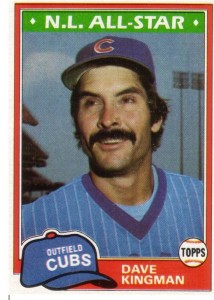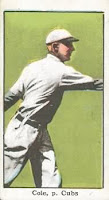King Day
As the nation celebrates Martin Luther King day, we honor the Cub players named King…
~King Cole 1886 (Cubs 1909-1912)
His real name was Leonard Leslie Cole. He started his baseball career as a pitcher with the Cubs in 1909. By 1910, he was the ace of the staff. He led the National League that season with a record of 20-4 and helped win a National League Pennant for the Cubs. His 20-4 record is the best winning percentage (.866) for a Cubs pitcher in the twentieth Century. He was immortalized as “King” Cole by Ring Lardner, who no doubt, got it from the children’s nursery rhyme ‘Old King Cole.’ King Cole didn’t stay with the Cubs very long. He won 18 games for them in 1911, and was traded (along with fan favorite Solly Hofman) to the Pirates for Tommy Leach early in the 1912 season. He later landed in the American League, where Cole gave up Babe Ruth’s first ever hit in the majors (a double on October 2, 1914). But this King Cole would not live to be a merry old soul. In 1915, he contracted a disease that knocked him out of baseball. Some sources say it was malaria, others say tuberculosis, and still others speculate it was syphilis, but whatever the disease, it took Cole’s life. He died on January 6th, 1916, a few months shy of his 30th birthday. (Photo: 1910 Tobacco Card)
~King Kelly 1857 (White Stockings 1880-1886)
King Kelly was famous for his running and hitting (he invented or at least perfected the hit and run), and he was said to have inspired the poem “Casey at the Bat,” but he was also considered a big fat cheater. If the umpire wasn’t looking, he would run from first to third by running across the diamond over the pitcher’s mound. He once came into the game in the middle of a play (from a drunken stupor on the bench) and announced “Kelly, Now Catching” so that he could take the throw and tag out the runner at home plate. (A rule was instituted after that banning something that nobody assumed needed to be spelled out—No mid-play substitutions). They even wrote a song about him called “Slide Kelly Slide.” The lyrics were…
Your running’s a disgrace,
Stay there, hold your base!
If someone doesn’t steal you,
And your batting doesn’t fail you,
They’ll take you to Australia!
Slide, Kelly, Slide
But that’s not what he was remembered for. Mike King Kelly was also a notorious drunk. Cap Anson hired a Pinkerton to keep an eye on him. When the report came in about Kelly’s off-the-field behavior, it claimed that he was out until 3 AM drinking lemonade. Kelly angrily denied it. “I was not! That was straight whiskey. I never drank lemonade at that hour in my life!” Kelly drank before, during, and after the games. One time the game had to be held up because Kelly was getting drunk with some fans in the box seats. Of course it caught up to him. The White Stockings (now known as the Cubs) got rid of him by selling him to Boston for $10,000 (which was a ton of money in those days). In Boston, the drinking took it’s toll. He had to be sobered up before every game in a Turkish bath. He lasted until 1893, but the last few years he was just a shell of the player he once was…and he wasn’t even that old. He drank himself to death the following year at the age of 36. 5000 fans came to see him at his funeral. King Kelly was elected into the Baseball Hall of Fame in 1945.
~King Lear 1894 (Cubs 1918-1919)
When your last name is “Lear”, there’s a good chance that even the semi-literate baseball crowd will nickname you “King”, and that’s what happened to Fred. King Lear was a backup infielder during his two seasons in Chicago. He only had a cup of coffee with the 1918 pennant winners (2 at bats), but then got the most extensive playing time of his career the following year. The Cubs traded him to the Giants in 1920.
~Chick King 1930 (Cubs 1958-1959)
The centerfielder was mainly a career minor leaguer who got an occasional taste of the show for the Tigers, Cardinals, and Cubs. Over five seasons, he had only 76 career big league plate appearances. He was a .280 hitter in his eleven years of minor league ball.
~Jim King 1932 (Cubs 1955-1956)
King broke into the big leagues with the Cubs and got significant playing time in right field for two seasons. He hit 26 homers for the Cubs and was traded to the Cardinals in 1957 for Bobby Del Greco. King played eleven seasons in the big leagues, including five full seasons as a starter with the Washington Senators. He also played for the Giants, White Sox and Indians.
~Ray King 1974 (Cubs 1999)
King got his start with the Cubs, but pitched another nine years after he left them. In 593 career appearances he never started a game.
 ~Dave Kingman 1948 (Cubs 1978-1980)
~Dave Kingman 1948 (Cubs 1978-1980)
All the elements were in place for a wonderful long term marriage between the Cubs and Dave Kingman. He was a prodigious slugger; his home runs were already the stuff of legend. The Cubs were having trouble drawing fans, and he was the kind of player that brought people to the ballpark. In addition to that, he was a local boy (Prospect High School) returning to play in front of his home town fans. He even lived up to his billing; slugging home runs onto Waveland Avenue with regularity. Yet, by the time Kingman left Chicago, he might have been one of the most hated players in Cubs history. How did things go so horribly wrong? His first year with the Cubs (1978) he hit 28 homers, and some of them were dramatic, but his personality was already rubbing people the wrong way. His 1979 season was one of the best in Cubs history (he hit 48 homers), so his teammates and fans looked the other way as he said and did things that irritated one and all. It wasn’t 1980 that things really got ugly, and they got ugly in a hurry.
In April Kingman caused a stir when he threw a bucket of ice water on a newspaper reporter for the Daily Herald. This unprovoked attack (the reporter was interviewing someone else–Lenny Randle) led to a reprimand from the league office, but not much else.
In June, Kingman didn’t show up for a game. He had been given the previous day off to fly to San Diego after his home was burglarized, but he didn’t make it back in time for the next day’s game. The Cubs fined him for that. When he finally did show up the next day he showed up with a sore shoulder and had to be put on the disabled list. He was out for two months.
During that time on the DL, the Cubs scheduled “Dave Kingman Day” at the ballpark. They gave away 15,000 Dave Kingman t-shirts, and even though he was in town that day, he didn’t show up at the ballpark. He did a paid gig promoting Jet Skis instead.
By the end of that season people hated him. Mike Royko, who had been a Cubs fan for forty years, publicly switched his allegiance to the White Sox because he despised Kingman so much. (He called him Ding Dong instead of his previous nickname King Kong).
In the off season the Cubs did what they had to do; they traded Kingman back to the Mets. After news of Kingman’s trade became public, his teammates all expressed relief that he was gone. Royko even became a Cubs fan again.And though Dave Kingman continued to slug homers (he hit another 172 in his career), and retired with the most career homers of any player not in the Hall of Fame, he never even got a sniff from Hall of Fame voters. It’s hard to get votes from baseball writers when you’re remembered for throwing ice cold water at one of their colleagues. (Photo: Topps 1980 Baseball Card)






Leave a Reply